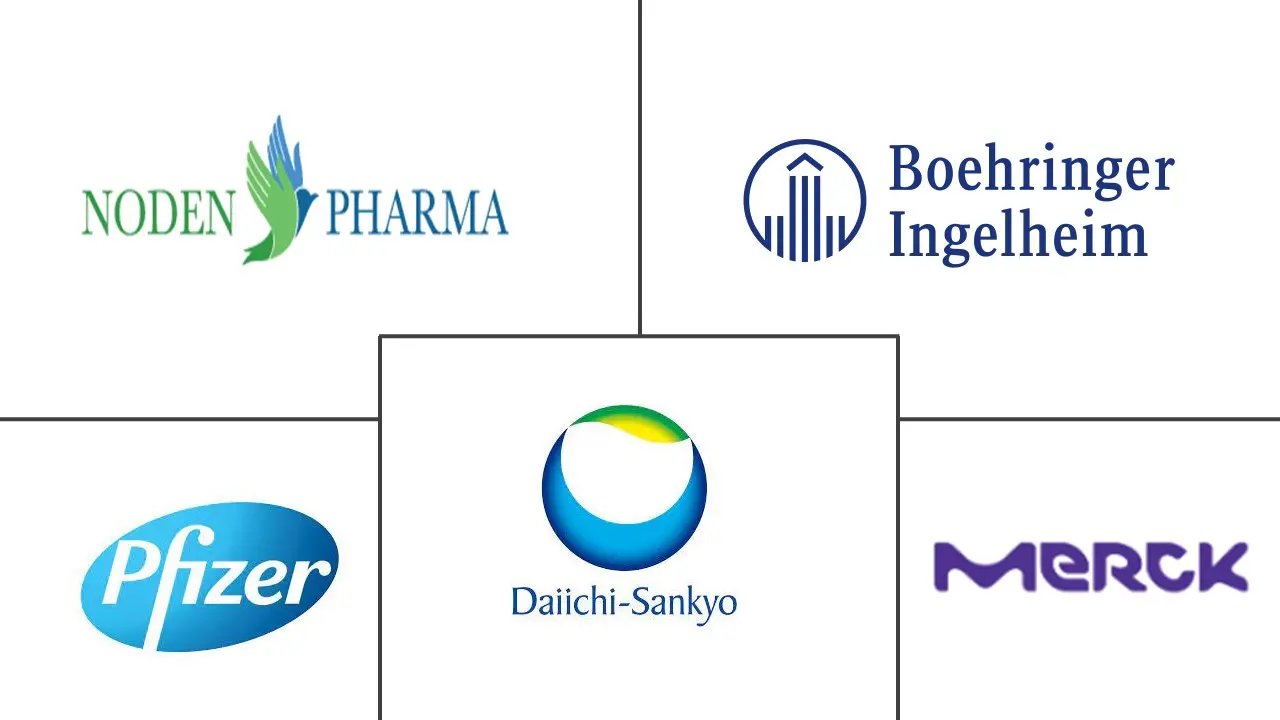Global Anti-hypertensive Drugs Market Size and Share
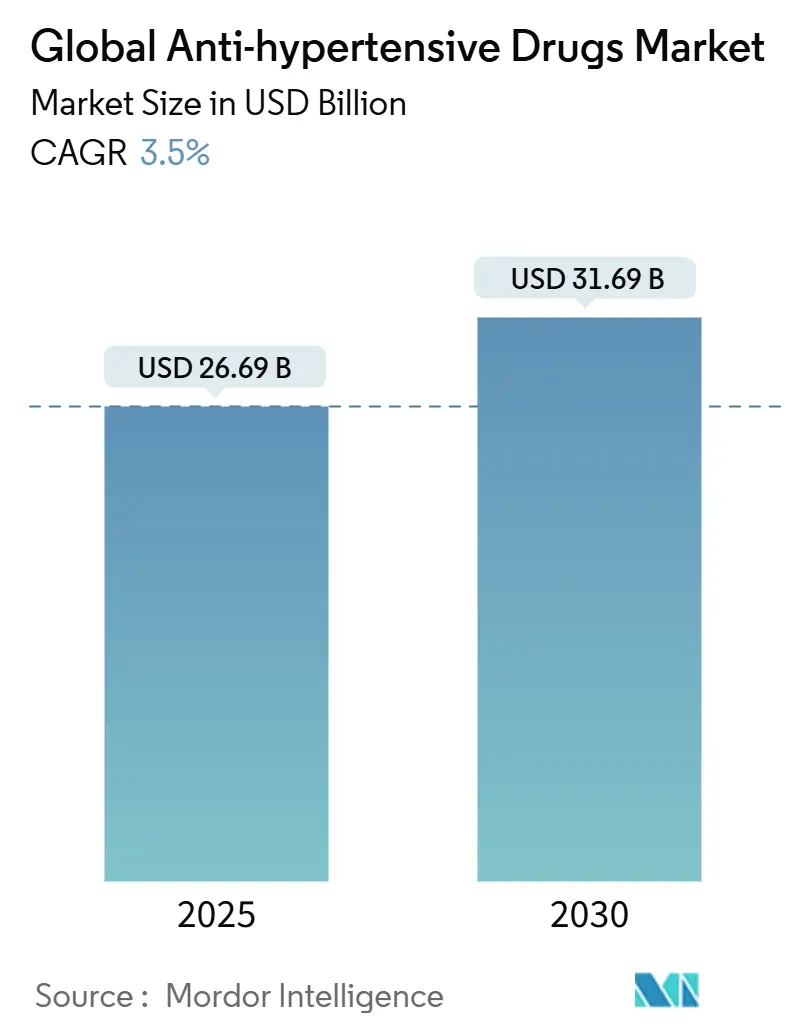
Global Anti-hypertensive Drugs Market Analysis by Mordor Intelligence
The antihypertensive drugs market is valued at USD 26.69 billion in 2025 and is forecast to reach USD 31.69 billion in 2030, advancing at a 3.5% CAGR. Uptake is anchored in escalating hypertension prevalence, an older global population, and steady innovation in fixed-dose combinations that improve adherence. Emerging long-acting injectable therapies and AI-enabled dose-titration platforms add fresh clinical value while generic competition tempers overall price growth. Asia-Pacific outpaces other regions on the back of rapid urbanization, salt-heavy diets, and widening health-insurance schemes. Meanwhile, North America sustains the largest revenue pool through early adoption of novel mechanisms, broad reimbursement, and entrenched cardiology care pathways. Throughout 2025–2030, companies with balanced portfolios of breakthrough assets and cost-competitive generics are positioned to capture incremental demand, even as patent cliffs squeeze margins for older brands.
Key Report Takeaways
- By drug class, Angiotensin II Receptor Blockers led with 31.43% of antihypertensive drugs market share in 2024; Renin Inhibitors are projected to expand at a 4.23% CAGR to 2030.
- By route of administration, oral formulations accounted for 64.45% share of the antihypertensive drugs market size in 2024, whereas transdermal delivery is advancing at a 4.71% CAGR through 2030.
- By distribution channel, retail pharmacies held 48.65% revenue share in 2024; online pharmacies are forecast to post the highest CAGR at 5.19% between 2025–2030.
- By geography, North America captured 35.55% of the antihypertensive drugs market size in 2024, while Asia-Pacific is set to grow fastest at 5.67% CAGR through 2030.
Global Anti-hypertensive Drugs Market Trends and Insights
Driver Impact Analysis
| Driver | (~) % Impact on CAGR Forecast | Geographic Relevance | Impact Timeline |
|---|---|---|---|
| Accelerating prevalence of obesity and metabolic syndrome | +0.8% | Global, with highest impact in North America and Asia-Pacific | Medium term (2-4 years) |
| Growth of fixed-dose combination (FDC) therapies | +0.6% | Global, particularly Europe and North America | Short term (≤ 2 years) |
| Expanding reimbursement for single-pill regimens | +0.4% | North America and Europe | Medium term (2-4 years) |
| Uptake of once-weekly antihypertensive injectables (GLP-1 combos) | +0.3% | North America and Europe, expanding to Asia-Pacific | Long term (≥ 4 years) |
| Wider use of remote BP monitoring driving early prescription | +0.5% | Global, led by developed markets | Short term (≤ 2 years) |
| AI-powered dose-titration platforms improving outcomes | +0.2% | North America and Europe | Long term (≥ 4 years) |
| Source: Mordor Intelligence | |||
Accelerating Obesity and Metabolic Syndrome
Metabolic syndrome affects roughly one-third of adults worldwide, and hypertension co-exists in 85% of these patients. Clinicians are moving toward agents that simultaneously address weight, glycemic control, and blood pressure, particularly GLP-1 receptor agonists that cut systolic readings by 7–10 mmHg independent of weight loss. Health-system models estimate that unchecked hypertension could push annual cardiovascular treatment costs from USD 160 billion in 2020 to USD 513 billion by 2050, reinforcing the economic case for aggressive early therapy [1]Source: American Heart Association, “Forecasting the Economic Burden of Cardiovascular Disease,” ahajournals.org.
Growth of Fixed-Dose Combination Therapies
Roughly 70% of patients need two or more antihypertensive agents, yet adherence drops as pill count rises. FDA approval of the first triple-combination tablet in 2025 signals a regulatory green light for upfront multi-drug products that achieved 70% control rates versus 37% on placebo. Health-economic studies put annual hospitalization savings at USD 873 per adherent patient, spurring payers to prioritize such regimens.
Expanding Reimbursement for Single-Pill Regimens
Medicare and large private plans have moved combination therapies into preferred tiers after real-world data showed 42% goal attainment on combination products against 21% for monotherapy. In a significant move, Idorsia secured FDA approval for Tryvio, the first endothelin receptor antagonist for hypertension [2]Source: Idorsia Pharmaceuticals, “FDA Approval of Aprocitentan,” idorsia.com . This shift improves access for patients and pressures single-agent incumbents to show clear differentiation or transition toward fixed-dose formats.
Uptake of Once-Weekly GLP-1 Combination Injectables
Long-acting injectables tackle adherence challenges tied to daily tablets, with tirzepatide and semaglutide producing 15–20 mmHg systolic declines in monthly-dosed studies. Patients with concomitant diabetes favor the convenience, and providers value a single therapy covering multiple risk factors, a dynamic expected to build over the long term.
Restraint Impact Analysis
| Restarint | (~) % Impact on CAGR Forecast | Geographic Relevance | Impact Timeline |
|---|---|---|---|
| Patent cliffs for blockbuster ARBs & CCBs | -0.7% | Global, particularly North America and Europe | Short term (≤ 2 years) |
| Low adherence due to asymptomatic nature of hypertension | -0.4% | Global, with higher impact in developing markets | Medium term (2-4 years) |
| Single-use plastics ban impacting parenteral packaging | -0.2% | Europe and select developed markets | Medium term (2-4 years) |
| Emerging nutraceutical substitutes in key Asian markets | -0.3% | Asia-Pacific, particularly China and India | Long term (≥ 4 years) |
| Source: Mordor Intelligence | |||
Patent Cliffs for Blockbuster ARBs & CCBs
Entresto loses U.S. exclusivity in mid-2025, and multiple ARB and CCB molecules face similar expiries, inviting rapid generic entry that historically erodes branded volume by up to 90% within a year. Manufacturers are countering with novel formulations and combination products, though payers favor generics for cost control.
Low Adherence Due to Asymptomatic Nature of Hypertension
Systematic reviews show 45.2% of patients lapse on therapy, directly capping prescription demand. Medicare models suggest that lifting adherence to 80% would save USD 13.7 billion annually, highlighting economic stakes and spurring investments in smart packaging, reminder apps, and long-acting modalities.
Segment Analysis
By Drug Class: Leadership of ARBs Amid Emerging Mechanisms
Angiotensin II Receptor Blockers held 31.43% antihypertensive drugs market share in 2024 thanks to proven cardio-renal benefits and favorable tolerability. Renin Inhibitors, although smaller, will climb at 4.23% CAGR as physicians adopt new pathways for resistant patients. Endothelin receptor antagonists and aldosterone synthase inhibitors, newly approved in 2025, bring additional options for hard-to-treat cases. Beta Blockers and some older Calcium Channel Blockers lose ground due to metabolic side effects, while diuretics gain renewed interest through low-dose formulations. Pipeline diversity underscores a shift toward precision mechanisms addressing comorbidity clusters and resistant hypertension niches.
The antihypertensive drugs market continues to reward classes that combine efficacy with favorable side-effect profiles. Lifecycle strategies now favor triple-combination tablets that integrate ARBs with CCBs or diuretics, anchoring brand loyalty even amid generic pressure. Novel mechanisms are expected to command premium pricing where they demonstrate clear outcome advantages, cushioning revenue against pending patent expiries. Manufacturers with broad portfolios straddling generics and innovations will navigate the transition most effectively.
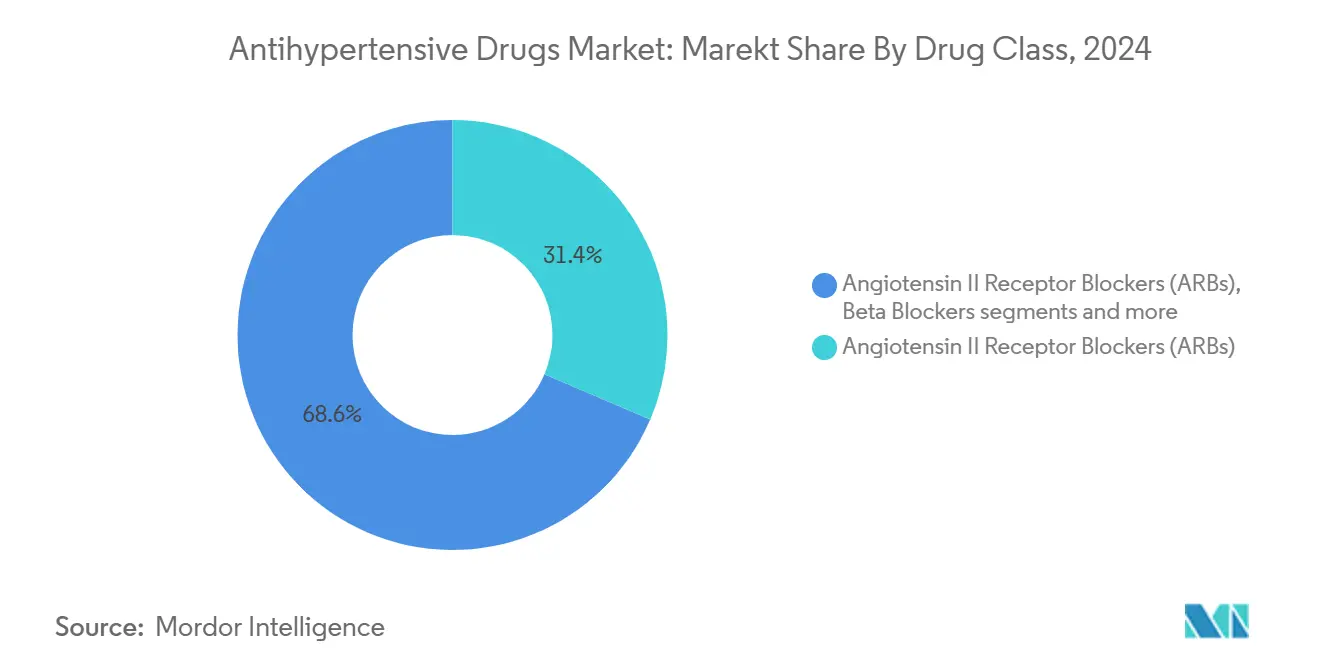
Note: Segment shares of all individual segments available upon report purchase
By Route of Administration: Oral Dominance Faces Innovation Pressure
Oral dosage retained 64.45% of antihypertensive drugs market size in 2024, reflecting patient familiarity and cost efficiency, yet non-oral routes are gaining traction. Transdermal systems post the quickest growth at 4.71% CAGR, driven by microneedle patches that improve permeation and weekly wear convenience. Injectable depots tied to GLP-1 combinations open a new adherence-friendly segment, particularly for patients with multiple metabolic conditions. Oral brands are responding through extended-release beads and abuse-deterrent coatings to remain competitive.
The market’s route mix will steadily diversify as technology advances. Parenteral formats could reach double-digit share in high-income countries by 2030, especially where digital health programs package injectables with monitoring services. Companies investing early in formulation science and patient-centric delivery stand to capture upside beyond the maturing tablet segment.
By Distribution Channel: Retail Hubs Converge with Digital Platforms
Retail pharmacies controlled 48.65% revenue in 2024 and retain a counseling advantage for chronic disease care. Yet online pharmacies record the highest CAGR at 5.19%, fueled by telemedicine, door-step delivery, and subscription models. Hospital pharmacies remain integral for complex polypharmacy and inpatient titration, but outpatient trends favor hybrid models.
Digital transformation is prompting brick-and-mortar chains to integrate e-commerce storefronts and data-driven adherence programs. Pharmaceutical firms collaborate with both pure-play digital platforms and omnichannel retailers to ensure broad, frictionless access. Success now depends on pairing competitive pricing with value-added services such as refill reminders and virtual consults.
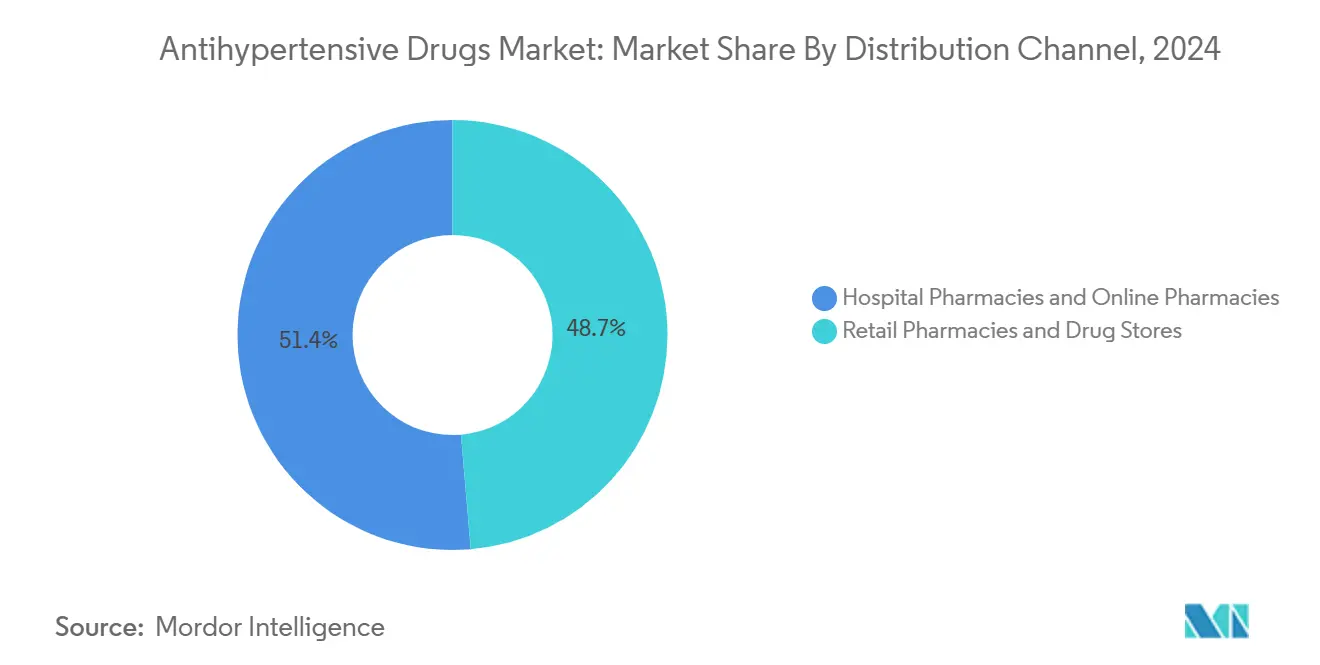
Note: Segment shares of all individual segments available upon report purchase
Geography Analysis
North America captured 35.55% of 2024 revenue, leveraging sophisticated cardiology networks, strong insurance coverage, and fast uptake of novel classes. The United States leads, buoyed by premium prices and early use of digital health. Canada emphasizes cost-effectiveness, leaning on generics, while Mexico grows volume as coverage expands across public programs.
Europe contributes steady mid-single-digit growth under mature health systems that weigh cost and innovation in equal measure. Germany and the United Kingdom spearhead clinical adoption of advanced mechanisms, whereas Southern Europe leans on high generic penetration. Value-based contracting accelerates fixed-dose uptake in major EU markets.
Asia-Pacific stands out as the fastest-expanding region with a 5.67% CAGR. China’s bulk-procurement policies have cut prices yet boosted volumes, while India benefits from large-scale manufacturing and rising domestic demand. Japan’s aging demographic sustains spending on cardio-metabolic care. Local salt-sensitivity profiles and genetic variations prompt region-specific research programs, creating scope for differentiated therapies.
South America shows gradual improvement amid economic recovery and hypertension awareness campaigns, though currency volatility tempers premium-drug uptake. Middle East and Africa remain nascent but promising as governments invest in non-communicable disease control and private insurance penetration rises.

Competitive Landscape
Global market control rests with a cadre of multinational firms combining legacy blockbusters, broad generic arsenals, and innovation pipelines. Novartis, Pfizer, AstraZeneca, and Johnson & Johnson defend share through life-cycle-managed ARB and CCB portfolios, while simultaneously advancing next-wave agents such as aldosterone synthase inhibitors. Chinese manufacturers leverage cost advantages to expand generics in emerging economies.
Patent expiries in 2025–2027 intensify competition as at least ten generic makers target high-volume ARBs. Price erosion pressures branded revenue, yet innovators counter with fixed-dose launches and long-acting injectables that carry stronger barriers to entry. Strategic moves include co-development of AI dose-optimization software, acquisition of late-stage biotech assets, and regional manufacturing expansions to secure supply resilience.
Biotech disruptors focus on RNA interference, gene-editing approaches, and once-biannual depot formulations. Mineralys Therapeutics reported a 19 mmHg drop in Phase 3 trials for lorundrostat, underscoring the bar for novel therapy differentiation. Partnerships between pharma and digital-health firms enable integrated solutions that blend medication, remote monitoring, and coaching, setting new standards for hypertension management services.
Global Anti-hypertensive Drugs Industry Leaders
-
Pfizer Inc.
-
C.H. Boehringer Sohn AG & Ko. KG
-
Noden Pharma DAC
-
Daiichi Sankyo Company Limited
-
Merck KGaA
- *Disclaimer: Major Players sorted in no particular order
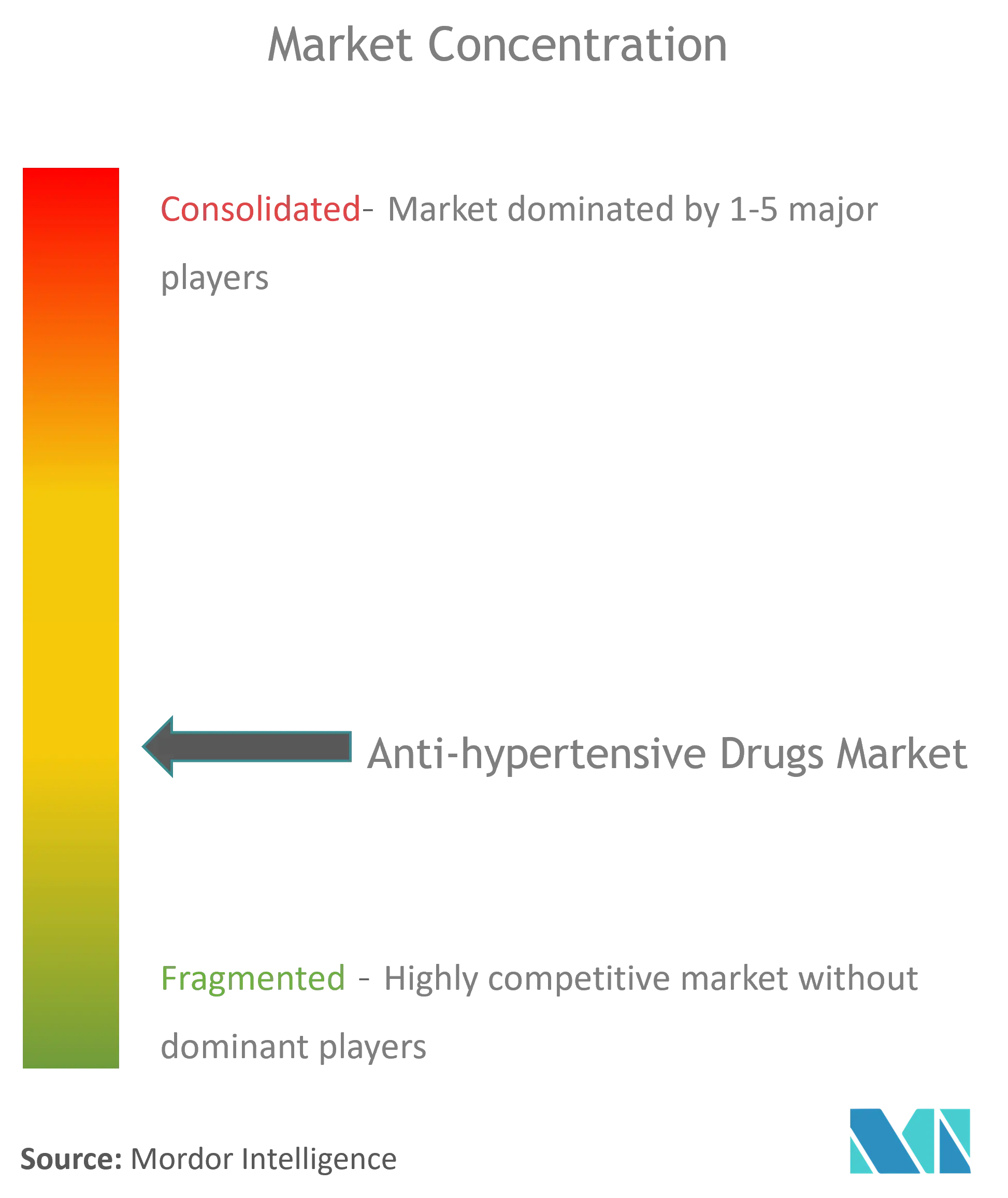
Recent Industry Developments
- June 2025: FDA approved Widaplik, the first triple-combination telemisartan/amlodipine/indapamide tablet, with U.S. launch slated for Q4 2025.
- May 2025: FDA cleared HemiClor 12.5 mg chlorthalidone tablets, offering a low-dose diuretic alternative.
- March 2025: Mineralys Therapeutics reported positive Phase 3 lorundrostat data, achieving 19 mmHg systolic reduction and preparing an NDA filing.
Research Methodology Framework and Report Scope
Market Definitions and Key Coverage
Our study defines the anti-hypertensive drugs market as all branded or generic pharmaceutical products whose primary indication is the chronic or acute reduction of systemic arterial blood pressure, irrespective of therapeutic class, ACE inhibitors, ARBs, diuretics, beta-blockers, renin inhibitors, calcium-channel blockers, alpha-agents, vasodilators, and fixed-dose combinations, sold through any prescription channel worldwide.
Scope exclusion: veterinary antihypertensives, single-agent cardiovascular drugs used off-label for blood-pressure control, and device-based interventions are not counted.
Segmentation Overview
- By Test Type (Value)
- Culture-based Tests
- Smear Microscopy
- Nucleic Acid Amplification Tests (NAAT)/PCR
- Interferon-Gamma Release Assays (IGRA)
- Tuberculin Skin Test (Mantoux)
- Radiographic & Imaging Tests
- Other Tests
- By Technology (Value)
- Culture-based
- Molecular Diagnostics (PCR/NAAT)
- Immunoassays (IGRA/LAM)
- Radiology/X-ray
- AI-enhanced Digital Microscopy
- Others
- By End-User (Value)
- Hospitals & Clinics
- Diagnostic Laboratories
- Academic & Research Institutes
- Others
- By Geography (Value)
- North America
- United States
- Canada
- Mexico
- Europe
- Germany
- United Kingdom
- France
- Italy
- Spain
- Rest of Europe
- Asia-Pacific
- China
- India
- Japan
- South Korea
- Australia
- Rest of Asia-Pacific
- South America
- Brazil
- Argentina
- Rest of South America
- Middle East and Africa
- GCC
- South Africa
- Rest of Middle East and Africa
- North America
Detailed Research Methodology and Data Validation
Primary Research
Mordor analysts interviewed hospital pharmacists in the United States, cardiologists in Germany, procurement heads at Indian generics firms, and payor representatives across ASEAN. These discussions clarified average daily doses, rebate structures, and forthcoming guideline changes, allowing us to validate secondary findings and plug regional gaps before final modeling.
Desk Research
We began with country-level epidemiology from the WHO Global Health Observatory, CDC NHANES, and the International Society of Hypertension, which frame treated-patient pools. Drug utilization and pricing baselines were drawn from publicly available national formularies, UN Comtrade shipment data for key APIs, and quarterly retail audit snapshots released by ministries of health in Japan, Brazil, and South Africa. We also consulted peer-reviewed journals such as The Lancet Hypertension series for combination therapy uptake trends.
To sharpen company revenue splits, we referenced D&B Hoovers profiles, while Questel patent analytics helped us understand post-patent cliff generic penetration. Additional inputs came from investor presentations, 10-Ks, FDA approval databases, and major trade association white papers. This list is illustrative; many other public domain sources informed data collection and cross-checks.
Market-Sizing & Forecasting
A top-down prevalence-to-treated-cohort build-up estimated demand by combining adult hypertension prevalence, diagnosed share, treatment rate, and mean daily dose. Results were stress tested through selective bottom-up roll-ups of manufacturer sales sampled via channel checks. Key variables like generic share progression, fixed-dose combination adoption, average retail price per standard unit, emerging market diagnosis uptick, and post-patent erosion curves drive the model. Multivariate regression with ARIMA error smoothing projected 2026-2030 values, while scenario analysis captured pricing or guideline shocks. Where disaggregated volume data were incomplete, regional ASP back-solves ensured internal consistency.
Data Validation & Update Cycle
Outputs pass a two-layer analyst review in which variance versus historical trends, peer values, and real-time tender prices is flagged. Anomalies trigger re-contact of earlier respondents. Reports refresh annually; material regulatory or recall events prompt interim updates so clients receive the latest view.
Why Mordor's Anti-hypertensive Drugs Baseline Commands Reliability
Published estimates often diverge because firms mix cardiovascular categories, apply differing price nets, or refresh models irregularly.
Key gap drivers include: some studies bundle parenteral vasodilators or pulmonary hypertension agents outside our scope; others extrapolate hospital list prices without generic erosion; still others apply uniform penetration rates and overlook faster diagnosis gains in Asia-Pacific, which Mordor captures through annual fieldwork.
Benchmark comparison
| Market Size | Anonymized source | Primary gap driver |
|---|---|---|
| USD 26.69 B (2025) | Mordor Intelligence | - |
| USD 25.88 B (2025) | Global Consultancy A | Excludes injectables and uses static generic discount across regions |
| USD 38.03 B (2025) | Industry Statistics Firm B | Adds broader cardiovascular combos and reports gross manufacturer sales |
| USD 32.84 B (2025) | Specialist Publisher C | Relies on limited primary interviews and biennial refresh cadence |
In sum, our disciplined scope, annually refreshed epidemiology, and dual-path validation give decision-makers a balanced, transparent baseline that aligns closely with real-world prescription and pricing dynamics.
Key Questions Answered in the Report
Q1. What is the current size of the antihypertensive drugs market?
A1. The antihypertensive drugs market stands at USD 26.69 billion in 2025 and is projected to reach USD 31.69 billion by 2030.
Q2. Which drug class leads global sales?
A2. Angiotensin II Receptor Blockers hold the largest share at 31.43% of 2024 revenue, thanks to strong efficacy and tolerability.
Q3. Which region will grow fastest through 2030?
A3. Asia-Pacific is expected to post the highest CAGR at 5.67%, driven by rising hypertension prevalence and expanding healthcare access.
Q4. How are fixed-dose combinations influencing the market?
A4. Triple- and dual-agent tablets improve adherence and have gained favorable reimbursement, boosting their uptake and lifting overall market value.
Q5. What impact will patent expiries have between 2025–2027?
A5. Patent cliffs for major ARBs and CCBs will intensify generic competition, likely depressing branded prices but widening patient access.
Page last updated on:
